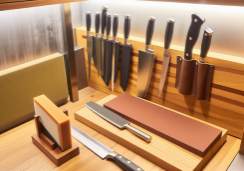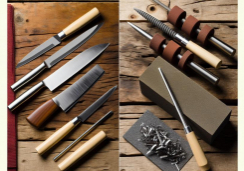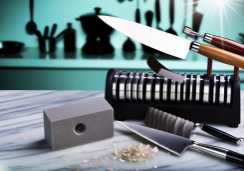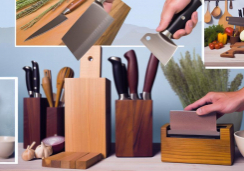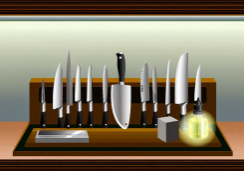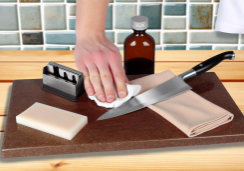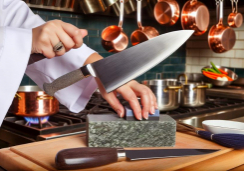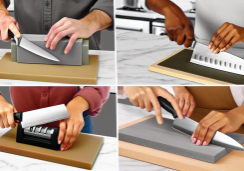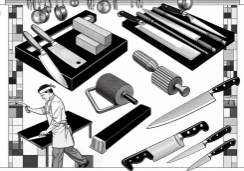12 Essential Tips for Durable Kitchen Knife Care
Just as a samurai's soul is said to reside in his katana, the spirit of your kitchen lies within the edges of your knives. You've invested in a quality set, and with the right care, they can last a lifetime, becoming an extension of your culinary prowess.
However, neglect them, and you'll find your blades dull and your efforts in the kitchen frustrating. You wouldn't drive your car without regular oil changes and tire rotations, would you? Similarly, your knives demand attention to maintain their edge.
To ensure your blades remain as sharp and pristine as the day you first held them, you must master the art of knife care. Stick with me, and you'll discover the secrets to protecting your metallic companions, tackling everything from the proper hand washing technique to addressing those pesky rust spots that threaten the longevity of your beloved cutlery.
What's at stake isn't just the well-being of your knives, but the efficiency and enjoyment of your culinary creations.
Selecting the Right Knives
Choosing the right knives for your kitchen arsenal can significantly enhance your culinary efficiency and precision. You need a set that's both versatile and designed to last. Don't be swayed by quantity; a few quality pieces trump a drawer full of subpar cutlery.
Start with a chef's knife, the cornerstone of your collection. Opt for an 8 to 10-inch blade – it's the workhorse for chopping, slicing, and mincing. You'll want one that feels balanced and comfortable in your hand, with a sharp, high-carbon stainless steel blade for edge retention and ease of sharpening.
Next, a paring knife is essential for delicate tasks like peeling and coring. A blade of 3 to 4 inches offers maneuverability without sacrificing control.
For bread and tomatoes, a serrated knife is your go-to, sawing through crusts and skins effortlessly.
Consider a boning knife if you frequently prepare meat and fish. Its narrow, flexible blade is perfect for removing bones and skinning.
Invest in knives forged from a single piece of steel, with full tang construction for durability and balance. Look for well-fitted handles, preferably riveted, for a secure grip.
With these essentials, you're set to tackle any culinary challenge with confidence.
Proper Hand Washing Technique
After carefully selecting your kitchen knives, it's crucial you wash them correctly to maintain their edge and longevity.
You'll want to choose a mild detergent that won't corrode the blade, and apply gentle scrubbing techniques to avoid any damage.
Lastly, consider whether air-drying or towel-drying is best to prevent rust and keep your knives in top condition.
Choose Right Washing Soap
To maintain the integrity of your kitchen knives, select a mild dish soap that effectively cuts through grease without causing corrosion or dulling the blades. You're aiming for a soap that's tough on food remnants but gentle on the knife's material. Avoid soaps with harsh chemicals or abrasive agents, as these can damage the knife's finish and impair its cutting edge over time.
Opt for soaps labeled 'gentle,' 'pH-balanced,' or those designed for delicate items. These typically have a neutral pH and are less likely to react with the steel, ensuring your knives remain in top condition.
Moreover, if you're eco-conscious, there are environmentally friendly soaps that are also kind to your knives. Remember, the right soap preserves both the knives' performance and their appearance.
Gentle Scrubbing Methods
Gently scrubbing your kitchen knives with a soft sponge or cloth preserves their sharpness and prevents damage to the blade's surface. You'll want to avoid using abrasive pads or steel wool, as these can scratch and dull your knives. Instead, opt for a non-abrasive scrubber specifically designed for delicate surfaces.
Hold the knife by the handle and wash the blade from the spine down towards the edge, moving away from your body to reduce the risk of cuts. Be thorough yet careful around the cutting edge to maintain its integrity. Rinse the knife immediately with warm water to remove any soap residue, which can be corrosive if left to dry on the blade.
Always dry your knives promptly and completely with a soft towel to prevent rust.
Air-Dry Vs. Towel-Dry
While you might be tempted to let your kitchen knife air-dry, promptly towel-drying is the better option to prevent rust and maintain the blade's condition. Water can be a knife's enemy, leading to corrosion and dulling of the blade.
After hand washing your knife with a mild detergent and warm water, grab a soft, absorbent towel. Gently wipe the blade from the spine to the edge, keeping your fingers away from the sharp edge to avoid injury. Ensure you also dry the handle, as moisture can degrade its material over time.
Drying Knives Correctly
Ensuring your knives are thoroughly dry after washing not only preserves their sharpness but also prevents rust and handle deterioration. As a seasoned kitchen veteran, you'll appreciate the importance of proper knife maintenance. Drying your knives correctly is a critical step that's often overlooked, yet it's simple to incorporate into your routine.
When you're drying your knives, there's a right way to do it to ensure longevity and performance. Remember, residual moisture is the enemy of a durable knife. Here are three key tips:
- Use a Soft Cloth: Choose a microfiber or other soft cloth to avoid scratching the blade. Gently wipe down the blade and handle until completely dry.
- Dry Immediately: Don't let your knives sit wet. As soon as you finish washing them, dry them off. This habit prevents water spots and hinders corrosion.
- Store Properly: Once dry, store your knives in a knife block or on a magnetic strip away from moisture. Never toss them in a drawer where they can get banged up or collect moisture.
Honing Vs. Sharpening
You've probably noticed your knives losing their edge over time, which is where honing and sharpening come into play.
Honing realigns the blade's edge, maintaining the sharpness between more intensive sharpening sessions.
It's crucial to distinguish between the two: a honing rod keeps a knife's edge straight, while a sharpener actually removes material to create a new edge.
Understanding Honing Techniques
To maintain your kitchen knives' edge and performance, it's crucial to understand the difference between honing and sharpening. Honing straightens the edge of your knife, realigning the microscopic teeth without removing significant amounts of metal.
Here's how you can master honing techniques:
- Choose the Right Honing Steel: Opt for a rod that's longer than your largest knife and made from a material suited to your knives' hardness.
- Maintain the Correct Angle: Hold the knife at about a 15-20 degree angle to the honing steel for an effective alignment of the edge.
- Use Gentle Pressure: Glide the knife down the steel with light, consistent pressure, ensuring you cover the entire length of the blade.
Sharpening: When & How
While honing realigns your knife's edge, sharpening actually removes metal to create a new edge and should be done when honing no longer restores the blade's sharpness. Recognize the need for sharpening by the knife's performance – a dull blade will require more force to cut and is more prone to slipping, which can be dangerous. It's time to sharpen when slicing becomes a chore rather than a smooth action.
Use a whetstone or a quality knife sharpener for this task. Start with a coarse grit to shape the edge, then progress to a finer grit for finishing. Maintain a consistent angle – usually between 15 to 20 degrees – and use smooth, even strokes.
Regular sharpening extends your knife's lifespan and ensures optimal performance in the kitchen.
Honing Rods Vs. Sharpeners
Understanding when to use a honing rod versus a sharpener is key to maintaining your knife's edge, as each tool serves a distinct purpose in knife care. A honing rod realigns the edge of your knife, keeping it sharp between more intensive sharpening sessions. It's a maintenance tool, not a sharpener.
Sharpeners, on the other hand, remove material from the blade to create a new edge when honing is no longer effective.
- Honing Rods: Ideal for regular maintenance; use before each use to maintain a sharp edge.
- Sharpeners: Necessary for restoring a dull blade; use sparingly to create a new edge.
- Frequency: Regular honing extends time between sharpening, preserving your knife's lifespan.
Sharpening Frequency
You'll need to sharpen your kitchen knives regularly, aiming for every few months, to maintain a razor-sharp edge that ensures precision and safety in your cutting tasks. The exact frequency, however, depends on how often you use your knives and what you're cutting. A home cook typically needs less frequent sharpening than a professional chef who's slicing and dicing daily.
Consider the type of knife as well; harder steel found in high-quality knives can hold an edge longer, but when they do dull, they require a more skilled approach to sharpening. Softer steel, on the other hand, may need more frequent attention but is generally easier to sharpen.
You should also be mindful of the signs that indicate it's time to sharpen. If you notice your knife is squashing rather than slicing through a tomato, or you're having to apply more force than usual, it's probably time to sharpen the blade. Don't wait until it's completely blunt—keeping your knife consistently sharp is better for the knife and safer for you.
Appropriate Cutting Surfaces
Your knife's longevity is directly impacted by the cutting surface you use. Steer clear of hard materials like glass or stone that can dull blades quickly, and opt for wooden or plastic boards that provide a more forgiving surface.
Always ensure your cutting board is clean to prevent cross-contamination and to maintain the integrity of the knife's edge.
Choose Right Cutting Boards
Selecting the right cutting board is crucial for protecting your kitchen knives from premature dulling and ensuring their longevity. The right surface can make a significant difference in how your knife retains its edge.
Here are key points to consider when choosing a cutting board:
- Material Matters: Opt for wooden or plastic cutting boards. Bamboo, while harder than some woods, can still be knife-friendly. Avoid glass or stone, which can quickly blunt your blades.
- Density is Key: A good cutting board should have enough give to allow the knife to bite slightly into the surface, which helps maintain sharpness.
- Maintenance is Essential: Keep your boards clean and dry. Wooden boards require regular oiling to prevent warping and cracking.
Avoid Hard Surfaces
Having discussed the importance of choosing the right cutting board, it's equally crucial to avoid using your knives on hard surfaces such as glass, metal, or stone to maintain their sharpness.
These materials can quickly dull your blades, forcing you to sharpen them more frequently and shortening their lifespan.
Instead, opt for softer materials like wood or plastic, which provide a gentler cutting experience and help preserve the cutting edge of your knives.
Maintain Surface Cleanliness
Ensure your cutting surfaces are impeccably clean, as even the smallest particles can damage a knife's edge over time and interfere with the efficiency of your cuts. When you're prepping your ingredients, the last thing you want is to dull your knives or taint your food with residue from past meals.
Here are three essential maintenance tips for your cutting boards:
- Use separate boards: Have dedicated boards for different food types to prevent cross-contamination and protect your knives.
- Regular cleaning: Wash cutting boards with hot, soapy water after each use, and consider using a diluted bleach solution for deep sanitation.
- Immediate drying: Dry cutting boards thoroughly to prevent warping and the growth of bacteria, which can affect your knives and health.
Adhering to these practices will extend the life of your knives and ensure a pristine cutting experience.
Storing Knives Safely
Properly storing your kitchen knives not only protects their sharp edges but also ensures your safety whenever you reach for them. You've got to treat them with care, just like the culinary tools of art they are.
Start with a knife block or magnetic strip. A knife block holds your knives in a structured layout, preventing the blades from touching each other and dulling over time. Make sure the slots are wide enough to avoid scraping the knives as you slide them in and out.
Alternatively, a magnetic strip affixed to the wall saves counter space and keeps your knives visible and accessible. It's crucial, however, to attach knives with the spine leading to avoid blunting the cutting edge.
If you're tight on space, consider a knife guard or a felt-lined drawer insert. These options protect the blades from damage and prevent accidental cuts when you're rummaging for utensils. Just ensure that each knife has its own slot or guard to prevent contact with other tools.
Avoiding Dishwasher Damage
To maintain your knives' sharpness and integrity, steer clear of the dishwasher and instead hand wash them with gentle soap and warm water. The rough environment inside a dishwasher can be disastrous for your knives. High temperatures, potent detergents, and the jostling from water jets can all cause damage that's not only aesthetic but also functional.
By respecting your knives and treating them with care, you'll ensure they stay in top condition for years to come. Here's what you need to know to avoid dishwasher damage:
- Handle with Care: Always use a soft sponge or cloth to clean your knives. Abrasive scrubbers can scratch and dull the blade.
- Dry Promptly: After washing, immediately dry your knives with a towel to prevent rust and water spots from forming.
- Separate Storage: Don't toss your knives into the utensil basket with other items. This can cause knives to knock against other utensils, damaging the edges.
Using Blade Protectors
Investing in blade protectors can significantly extend the life of your kitchen knives by shielding their edges from unnecessary wear and tear. These simple accessories are indispensable for maintaining a sharp edge and preventing accidents when you're rummaging through drawers.
Here's what you need to know:
- Blade protectors come in various materials, such as plastic, felt-lined leather, or silicone. They're designed to snugly fit the shape of your knife, covering the edge to avoid contact with other utensils.
- Don't just buy any protector; ensure it's the right size and material for your knife. A loose protector can come off easily, defeating its purpose, while a tight one can cause damage when you're sliding the knife in and out.
- Use them consistently, especially if you're storing knives in a drawer rather than a block or on a magnetic strip. Even when transporting knives, perhaps for a barbecue or a cooking class, always use a protector. This prevents the blade from getting dull or nicked—and it keeps you safe.
Handling Blade Discoloration
While blade protectors are essential for maintaining a knife's sharpness, addressing the issue of blade discoloration will ensure your knives not only perform well but also look their best. Discoloration can occur due to a variety of reasons, including reaction to acidic foods or simply due to age and use. It's not just an aesthetic issue; it can sometimes indicate a more serious problem with the metal.
Here are a few steps to tackle blade discoloration:
- Clean Immediately After Use: Wash your knife by hand with warm soapy water right after using it, especially after cutting acidic foods, and dry it thoroughly to prevent spots from forming.
- Use a Gentle Polish: For stainless steel knives, you can use a non-abrasive metal polish to remove discoloration. Apply it according to the manufacturer's instructions and buff gently for a like-new shine.
- Avoid Harsh Chemicals: Steer clear of bleach or harsh chemicals that can exacerbate discoloration and damage the blade's integrity.
Addressing Rust Spots Promptly
Address rust spots on your kitchen knives quickly to prevent the spread of corrosion and maintain the blade's integrity. It's crucial to tackle these blemishes as soon as they appear; procrastination only leads to further damage.
When you notice a rust spot, don't panic. Instead, grab a mild abrasive, like baking soda mixed with water to form a paste, and apply it gently to the affected area using a soft cloth or sponge. Rub the paste in a circular motion, applying only light pressure to avoid scratching the metal.
For more stubborn rust, consider using a specialized knife cleaner or a rust eraser, which is designed for this purpose. After you've removed the rust, rinse the knife thoroughly with water and immediately dry it with a clean towel to prevent new rust from forming.
It's also wise to oil the blade with a food-safe mineral oil to create a protective barrier against moisture. Store your knives in a dry place and consider using a knife block or sheath to safeguard the blades from the humid environment of the kitchen.
Regular Inspection and Maintenance
Having tackled rust spots, it's essential to establish a routine for inspecting and maintaining your knives to ensure their longevity and optimal performance. Regular check-ups allow you to catch any issues before they become bigger problems. You'll want to look for signs of wear, such as dullness, nicks, or a loose handle, which can affect the knife's effectiveness and safety.
Here are key actions you should take:
- Inspect the Blade: Check for any damage or dulling. If it's dull, sharpen it; if there are nicks, consider having it professionally repaired.
- Tighten the Handle: Ensure the handle is securely attached to the blade. Any movement can be dangerous and should be fixed immediately.
- Clean Thoroughly: After each use, wash your knife by hand with warm, soapy water and dry it immediately to prevent moisture from damaging the blade or handle.
Are the Essential Tips for Durable Kitchen Knife Care the Same for All Types of Knives?
Yes, the durable kitchen knife care tips are applicable to all types of knives. Regular honing, hand washing, and proper storage are crucial for maintaining the sharpness and longevity of any knife. Additionally, using a cutting board and avoiding the dishwasher can help preserve the blade’s edge.
Conclusion
In conclusion, keep your kitchen knives in top-notch condition by choosing wisely and caring for them meticulously.
Hand wash and dry them promptly to prevent damage.
Hone regularly and sharpen as needed to maintain a razor edge.
Use blade protectors to avoid nicks.
Address any discoloration or rust quickly to preserve the integrity of the blade.
Inspect them routinely, ensuring they remain your reliable culinary partners for years to come.
Remember, a well-maintained knife is a chef's best friend.

